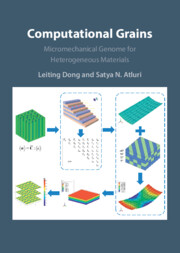Book contents
- Computational Grains
- Computational Grains
- Copyright page
- Contents
- Preface
- 1 Introduction
- 2 Computational Homogenization in the Micromechanics of Heterogeneous Materials
- 3 Direct Numerical Simulation of Materials Using Computational Grains
- 4 Trefftz Trial Functions for Computational Grains for Planar and 3D Problems
- 5 Computational Grains for Particulate Composites and Porous Materials
- 6 Computational Grains for Cylindrical Fiber Composites
- 7 Computational Grains for Nanocomposites
- 8 Computational Grains for Composites with Coated Inclusions
- 9 Computational Grains for Viscoelastic Composites
- 10 Computational Grains for Piezoelectric Composites/Porous Materials
- 11 Computational Grains with Embedded Microcracks in the Matrix and Inclusions
- 12 Multi-Scale Modeling of Composite Structures Using Computational Grains
- Index
- References
5 - Computational Grains for Particulate Composites and Porous Materials
Published online by Cambridge University Press: 05 October 2023
- Computational Grains
- Computational Grains
- Copyright page
- Contents
- Preface
- 1 Introduction
- 2 Computational Homogenization in the Micromechanics of Heterogeneous Materials
- 3 Direct Numerical Simulation of Materials Using Computational Grains
- 4 Trefftz Trial Functions for Computational Grains for Planar and 3D Problems
- 5 Computational Grains for Particulate Composites and Porous Materials
- 6 Computational Grains for Cylindrical Fiber Composites
- 7 Computational Grains for Nanocomposites
- 8 Computational Grains for Composites with Coated Inclusions
- 9 Computational Grains for Viscoelastic Composites
- 10 Computational Grains for Piezoelectric Composites/Porous Materials
- 11 Computational Grains with Embedded Microcracks in the Matrix and Inclusions
- 12 Multi-Scale Modeling of Composite Structures Using Computational Grains
- Index
- References
Summary
In this chapter, 2D Computational Grains (CGs) with elastic inclusions or voids and 3D CGs with spherical/ellipsoidal inclusions/voids or without inclusions/voids are developed for micromechanical modeling of composite and porous materials. A compatible displacement field is assumed along the outer boundary of each CG. Independent displacement fields in the CG are assumed as characteristic-length-scaled T-Trefftz trial functions. Muskhelishvili’s complex functions are used for 2D CGs, and Papkovich-Neuber solutions are used for 3D CGs to construct the T-Trefftz trial displacement fields. The Papkovich-Neuber potentials are linear combinations of spherical/ellipsoidal harmonics. To develop CG stiffness matrices, multi-field boundary variational principles are used to enforce all the conditions in a variational sense. Through numerical examples, we demonstrate that the CGs developed in this chapter can estimate the overall material properties of heterogeneous materials, and compute the microscopic stress distributions quite accurately, and the time needed for computing each SERVE is far less than that for the finite element method.
Keywords
Information
- Type
- Chapter
- Information
- Computational GrainsMicromechanical Genome for Heterogeneous Materials, pp. 72 - 109Publisher: Cambridge University PressPrint publication year: 2023
